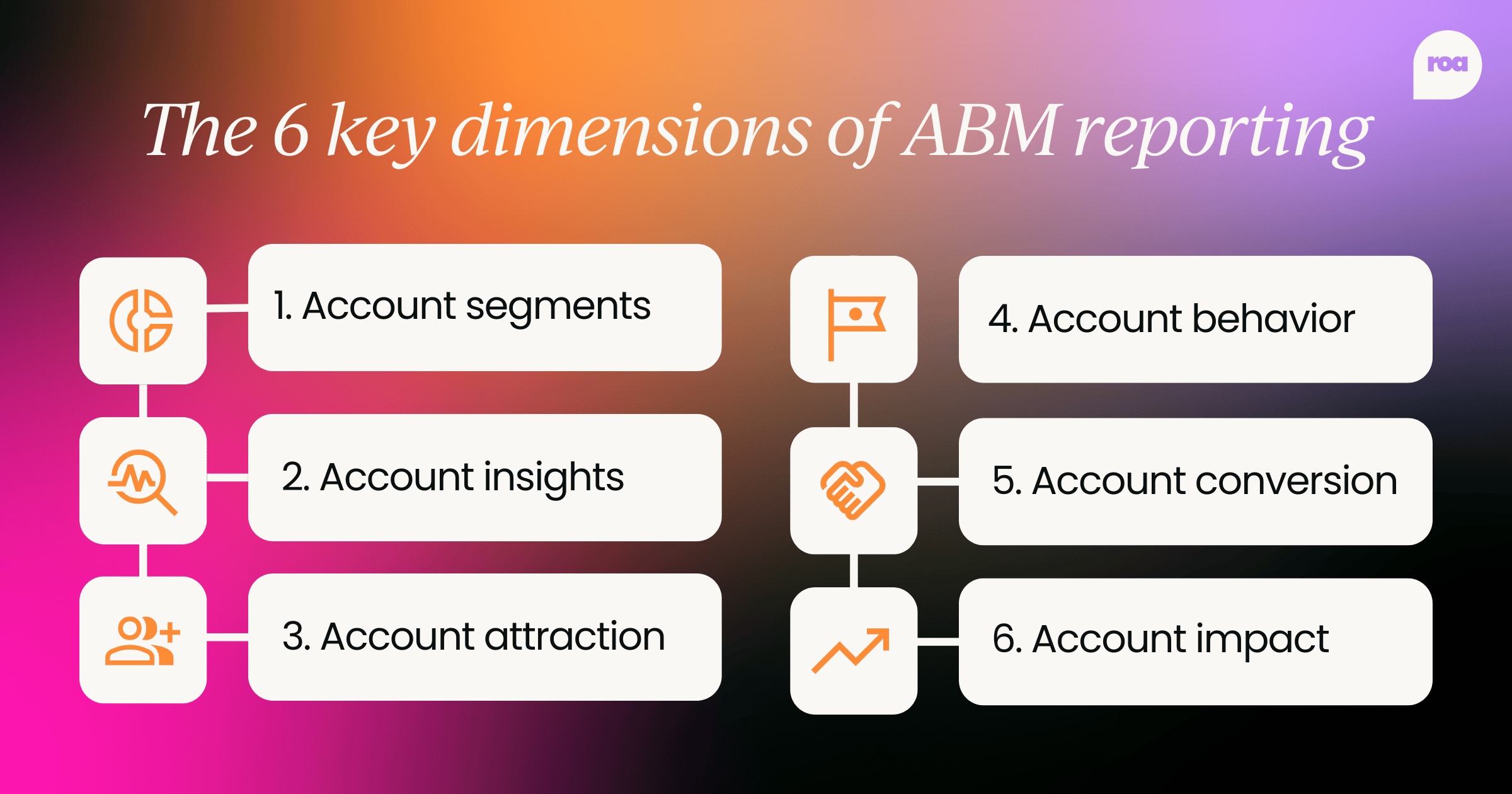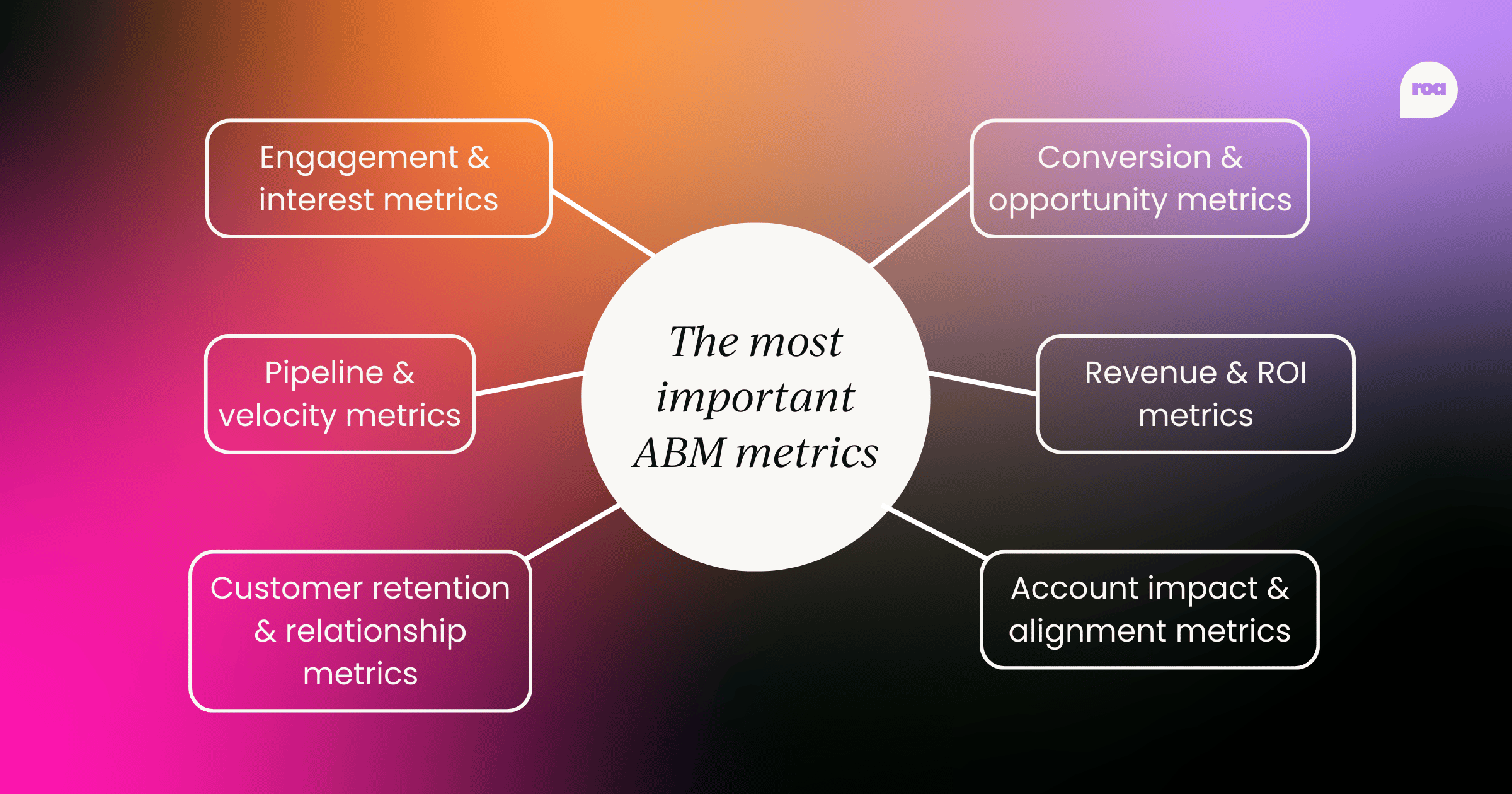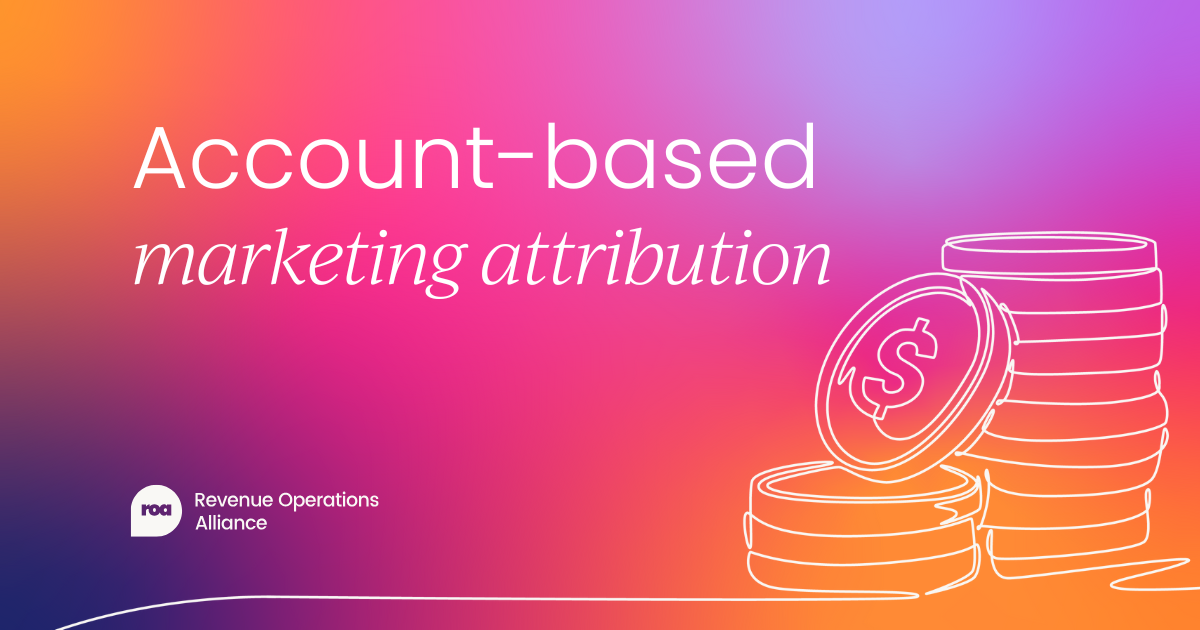What if the secret to your account-based marketing (ABM) success isn’t in the strategy, but actually in how well you can prove it’s working?
We’ve learned by now that ABM isn't just a trend – it's a proven strategy that focuses on selling directly to your highest-value accounts. In fact, 87% of marketers swear by it for better ROI. But while ABM might sharpen your focus on the right accounts, account-based marketing reporting is the macro lens that shows whether you're actually hitting the mark with them.
Sure – reporting isn’t anyone’s favorite task, but like any chore, the longer you leave it, the bigger the pile. But when it comes to account-based marketing reporting, tracking those numbers and behaviors is crucial to understanding if your efforts are paying off.
So, in this guide, we’ll break down how to measure and optimize your ABM strategy, turning all those interactions into solid insights. Because at the end of the day, you need more than a strategy that works – you need the data to prove it.
Ready to dive in? Let's get started.
TL;DR
Account-based marketing reporting is the process of tracking and evaluating the performance of targeted ABM strategies, focusing on key accounts rather than individual leads or customers. It measures how these accounts progress through the sales funnel and whether their engagement actually results in revenue.
What is account-based marketing reporting?
Account-based marketing reporting is how organizations track and evaluate the performance of their account-based marketing strategies. It’s about what their key accounts did, how they moved through the funnel, and whether those movements resulted in revenue.
Think of it almost like a GPS for your most valuable, high-impact accounts. It shows you where they started, what turns they took, how long the journey lasted, and whether they reached the crucial destination of a closed-won account.
The goal? To help marketing, sales, and RevOps teams stop guessing and give them the clarity to make smart, data-backed decisions.
Quite simply, it’s about tracking value over volume and more about the accounts over the specific buyers.

What’s the purpose of ABM reporting?
If ABM is about precision, reporting is the proof. It keeps everyone on the same page, focused on the same accounts, and driving toward the same revenue goals.
Some of the biggest benefits of account-based reporting are:
- Justified spend: With budgets under scrutiny, proving and showing ROI isn't optional.
- Aligned teams: Marketing and sales can’t operate in silos. Reporting bridges the gap between them.
- Focused efforts: Not every account is equal. Reporting shows who’s worth prioritizing.
- Smart growth: By doubling down on what’s working and ditching what’s not.

The 6 key dimensions of ABM reporting
The best ABM reporting doesn’t just spit out numbers – it tells a story. And the most impactful stories come through looking at performance across six clear dimensions:
- Account segments: Who are you targeting? Why? Group accounts by industry, company size, potential value – whatever makes sense for your business.
- Account insights: What do you know about these accounts? This includes firmographic data, intent signals, and where they are in the buyer’s journey.
- Account attraction: How did these accounts find you? Track the channels and campaigns that got their attention.
- Account behavior: What are they doing once they engage? Are they visiting your site, downloading content, or attending events?
- Account conversion: Are they moving down the funnel? Reporting should track actions like form fills, meeting bookings, and opportunity creation.
- Account impact: What’s the outcome? This includes revenue won, deal size, upsells, and retention.
While these six reporting dimensions might take some time to get to grips with, having an aligned and structured approach to your account-based marketing reporting will make your reporting far more effective in the long run.

The most important ABM metrics to track (and why)
Before we dive into these metrics, it’s important to note that account-based marketing metrics are no different from the metrics you would use to track any other marketing campaign or initiative. The only difference is that with account-based marketing reporting – surprise, surprise – you’re looking at them on an account-specific level.
There’s no shortage of metrics you could track, but not all metrics are created equal. For RevOps teams trying to measure what really makes an impact, these are the ones worth paying attention to:

1. Engagement & interest metrics
These metrics help you understand how well you're attracting and engaging target accounts.
- Number of target accounts: Track how many accounts you’re actively targeting, ensuring they align with your ideal customer profile (ICP). Clean up your list and look for intent signals to see which accounts are actively showing interest.
- Account engagement: Measure interactions like website visits, content downloads, email opens, and social interactions. Focus on engagement by account, not individual leads.
- Social engagement: Monitor interactions with your posts and ads from target accounts on platforms like LinkedIn and Twitter to gauge top-of-funnel interest and awareness.
2. Pipeline & velocity metrics
These track how accounts progress through the sales funnel and how quickly deals move.
- Sales velocity: How fast are your deals progressing? Measure time from first touch to meeting, from meeting to opportunity, and from opportunity to close. Faster deals mean more efficiency in your ABM strategy.
- Form completions & meetings booked: Track form fills and meetings to gauge intent and progress toward decision-makers. Pay attention to content type and who is filling out the forms (decision-maker vs. intern).
3. Conversion & opportunity metrics
These metrics help measure the success of turning engaged accounts into real opportunities and customers.
- Conversion rate: What percentage of your target accounts turn into opportunities, and which campaigns or tactics are most effective in driving conversions?
- Opportunities created & win rate: Track how many opportunities come from your ABM campaigns and the success rate of converting those into deals. This is the key to measuring campaign effectiveness.
4. Revenue & ROI metrics
Ultimately, these metrics measure the financial impact of your ABM efforts.
- Revenue won: The total revenue generated from ABM-sourced or ABM-influenced deals. Track initial deal value, renewals, cross-sells, and upsells.
- Average deal size: ABM should result in bigger deals. Track deal size across campaigns and segments to see if ABM is driving larger, more profitable sales.
- Upsells & renewals: ABM isn’t just about the first sale – it’s also about nurturing ongoing relationships. Track upsell revenue and cross-sell success to ensure your accounts keep buying.
5. Customer retention & relationship metrics
These help you understand the long-term value of your ABM efforts and whether your strategy supports customer retention.
- Churn rate & customer lifetime value (CLTV): Measure the retention of your target accounts and their long-term value. High churn among high-value accounts may indicate issues in your strategy.
- Net Promoter Score (NPS): A valuable tool for tracking satisfaction and loyalty. Happy customers may refer others, bringing in more business through word-of-mouth and referrals.
6. Account impact & alignment metrics
These provide insight into the effectiveness of your ABM approach in driving overall impact across teams.
- Referral & word-of-mouth leads: Keep track of referrals or social mentions from existing customers. These are crucial signals that your ABM strategy is building relationships and brand advocates.
- Team alignment metrics: Ensure that sales and marketing teams are aligned in their efforts to engage the right accounts. Metrics like meetings booked by channel help gauge which tactics work best across teams.
Tracking these key account-based marketing reporting metrics will give you a clear picture of your account-based strategy’s success, help you identify areas for improvement, and enable you to make smarter, data-backed decisions.
By mapping them this way, you can immediately identify any churn and optimize each stage more effectively.

How to build an account-based marketing reporting dashboard
Creating a reporting dashboard isn’t just about tracking data – it's about crafting a tool that helps you drive results. The best account-based marketing dashboards tell a story, rather than just listing numbers. Here’s how to build one that works for you:
1. Start with clear objectives
Before you dive into building the dashboard, outline the key metrics that will measure the success of your ABM efforts. Focus on metrics that align with your primary campaign goals – whether that’s engagement, pipeline progression, or revenue generation.
Use the metrics covered in this guide to make sure you're tracking what will truly impact your business.
2. Bring data together
Your dashboard should integrate data from your teams’ tools – CRM, marketing automation, social platforms, and ad campaigns. This unified view ensures you're not missing essential insights and can track everything in one central place.
3. Include financial metrics
You’re in it for the revenue after all, so make sure your dashboard connects marketing activity to tangible financial outcomes, such as:
- ROI: Track how much revenue you’re generating compared to what you’re spending.
- Average deal size: ABM (if working) should result in bigger deals – track this across your campaigns.
- Revenue per account: Measure the growth of your accounts, including upsell and cross-sell opportunities.
6. Keep it visual and actionable
Your dashboard needs to be more than just a pile of numbers. Use visuals like charts, graphs, and heatmaps to make the data easy to understand. It’s all about making key insights accessible and actionable.
A lot of dashboard platforms also have built-in predictive analytics functions that can help identify high-potential accounts so your team can act fast.
7. Ensure cross-team alignment
Since account-based marketing requires collaboration between sales, marketing, and leadership, your reporting dashboard should similarly give everyone a shared view.
8. Make it flexible
Your ABM strategy will evolve, and so should your dashboard. Build flexibility into the tool so you can adapt as your needs change. Customizable filters and adjustable reports will allow you to tweak the dashboard over time without starting from scratch.
A well-designed account-based marketing reporting dashboard keeps everyone on the same page, helping teams track the right accounts and act in the most impactful way. It’s not just about collecting data – it’s about using that data to make smarter, more strategic decisions. With the right dashboard, you can simultaneously optimize your strategy and prove its impact through reporting.
Final thoughts
Running a solid account-based marketing program is impressive. Proving it works? That’s what’ll make you a revenue hero.
Account-based marketing reporting isn’t just something you do because it’s on your checklist – it’s what helps you understand if all that hard work is actually paying off. By focusing on the right metrics, aligning your teams, and using a structured approach, you’ll be able to gather insights that can shape your strategy moving forward.
Whether it’s tracking engagement, watching how accounts move through the funnel, or seeing the revenue impact, clear and actionable reporting is what lets you know if you’re on the right track.
So, if you’re ready to step up your ABM game, it all starts with how well you report on it.







